Squatting exercises in older adults: kinematic and kinetic comparisons
- PMID: 12673148
- PMCID: PMC3474357
- DOI: 10.1249/01.MSS.0000058364.47973.06
Squatting exercises in older adults: kinematic and kinetic comparisons
Abstract
Purposes: Squatting activities may be used, within exercise programs, to preserve physical function in older adults. This study characterized the lower-extremity peak joint angles, peak moments, powers, work, impulse, and muscle recruitment patterns (electromyographic; EMG) associated with two types of squatting activities in elders.
Methods: Twenty-two healthy, older adults (ages 70-85) performed three trials each of: 1) a squat to a self-selected depth (normal squat; SQ) and 2) a squat onto a chair with a standardized height of 43.8 cm (chair squat; CSQ). Descending and ascending phase joint kinematics and kinetics were obtained using a motion analysis system and inverse dynamics techniques. Results were averaged across the three trials. A 2 x 2 (activity x phase) ANOVA with repeated measures was used to examine the biomechanical differences among the two activities and phases. EMG temporal characteristics were qualitatively examined.
Results: CSQ generated greater hip flexion angles, peak moments, power, and work, whereas SQ generated greater knee and ankle flexion angles, peak moments, power, and work. SQ generated a greater knee extensor impulse, a greater plantar flexor impulse and a greater total support impulse. The EMG temporal patterns were consistent with the kinetic data.
Conclusions: The results suggest that, with older adults, CSQ places greater demand on the hip extensors, whereas SQ places greater demand on the knee extensors and ankle plantar flexors. Clinicians may use these discriminate findings to more effectively target specific lower-extremity muscle groups when prescribing exercise for older adults.
Figures
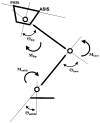
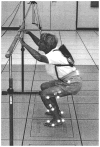
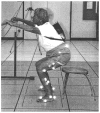
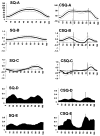
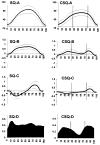
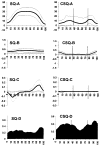


Similar articles
-
Lower-extremity biomechanics during forward and lateral stepping activities in older adults.Clin Biomech (Bristol). 2003 Mar;18(3):214-21. doi: 10.1016/s0268-0033(02)00204-8. Clin Biomech (Bristol). 2003. PMID: 12620784 Free PMC article. Clinical Trial.
-
Biomechanical attributes of lunging activities for older adults.J Strength Cond Res. 2004 Aug;18(3):599-605. doi: 10.1519/1533-4287(2004)18<599:BAOLAF>2.0.CO;2. J Strength Cond Res. 2004. PMID: 15320687 Free PMC article. Clinical Trial.
-
Trunk position influences the kinematics, kinetics, and muscle activity of the lead lower extremity during the forward lunge exercise.J Orthop Sports Phys Ther. 2008 Jul;38(7):403-9. doi: 10.2519/jospt.2008.2634. Epub 2008 Apr 15. J Orthop Sports Phys Ther. 2008. PMID: 18591759
-
Biomechanical demands of exercises commonly performed by older adults in falls prevention programs.Clin Biomech (Bristol). 2023 Jan;101:105863. doi: 10.1016/j.clinbiomech.2022.105863. Epub 2022 Dec 15. Clin Biomech (Bristol). 2023. PMID: 36549050
-
Contributions to the understanding of gait control.Dan Med J. 2014 Apr;61(4):B4823. Dan Med J. 2014. PMID: 24814597 Review.
Cited by
-
In vitro validation and reliability study of electromagnetic skin sensors for evaluation of end range of motion positions of the hip.Med Biol Eng Comput. 2011 Dec;49(12):1405-12. doi: 10.1007/s11517-011-0804-5. Epub 2011 Jul 13. Med Biol Eng Comput. 2011. PMID: 21751065
-
The biomechanical demands of standing yoga poses in seniors: The Yoga empowers seniors study (YESS).BMC Complement Altern Med. 2013 Jan 9;13:8. doi: 10.1186/1472-6882-13-8. BMC Complement Altern Med. 2013. PMID: 23302513 Free PMC article. Clinical Trial.
-
The effect of cam FAI on hip and pelvic motion during maximum squat.Clin Orthop Relat Res. 2009 Mar;467(3):645-50. doi: 10.1007/s11999-008-0620-x. Epub 2008 Nov 26. Clin Orthop Relat Res. 2009. PMID: 19034598 Free PMC article.
-
Quantifying kinematic differences between land and water during squats, split squats, and single-leg squats in a healthy population.PLoS One. 2017 Aug 2;12(8):e0182320. doi: 10.1371/journal.pone.0182320. eCollection 2017. PLoS One. 2017. PMID: 28767683 Free PMC article.
-
SURGICAL TREATMENT FOR FEMOROACETABULAR IMPINGEMENT IN A GROUP THAT PERFORMS SQUATS.Rev Bras Ortop. 2015 Dec 8;47(4):488-92. doi: 10.1016/S2255-4971(15)30134-8. eCollection 2012 Jul-Aug. Rev Bras Ortop. 2015. PMID: 27047856 Free PMC article.
References
-
- Baker D, Nance S, Moore M. The load that maximizes the average mechanical power output during explosive bench press throws in highly trained athletes. J Strength Cond Res. 2001;15:20–24. - PubMed
-
- Baker D, Nance S, Moore M. The load that maximizes the average mechanical power output during jump squats in power-trained athletes. J Strength Cond Res. 2001;15:92–97. - PubMed
-
- Barry HC, Eathorne SW. Exercise and aging: issues for the practitioner. Med Clin North Am. 1994;78:357–376. - PubMed
-
- Bassey EJ, Fiatarone MA, O’Neill EF, Kelly M, Evans WJ, Lipsitz LA. Leg extensor power and functional performance in very old men and women. Clin Sci. 1992;82:321–327. - PubMed
-
- Boyden G, Kingman J, Dyson R. A comparison of quadriceps electromyographic activity with the position of the foot during the parallel squat. J Strength Cond Res. 2000;14:379–382.

